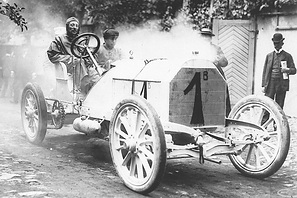After the rather unsuccessful debut of the Mercedes-Simplex 90 hp "Special racing cars" in the Paris - Madrid long-distance race and their subsequent destruction in the devastating fire that reduced the Daimler-Motoren-Gesellschaft assembly plant in Cannstatt to rubble on the morning of 10 June 1903, along with more than 90 vehicles, DMG was faced with the challenge of having to build new high-performance racing cars for the 1904 season.
From a technical point of view, the new car was very closely modelled on its 1903 predecessor. The large-volume four-cylinder unit with overhead intake and upright exhaust valves in an IOE valve arrangement was retained. The overhead intake valves were actuated by tappets and rocker arms, while the exhaust valves, which were arranged in a separate cast chamber on the side of the cylinder, were operated directly by a gear-driven camshaft below.
The oversquare, i.e. short-stroke, design of the 1903 four-cylinder engine, which was unusual for the era, was also retained, but its characteristics were slightly attenuated. Instead of 170 mm, the bore size for the 1904 model year cars was now only 165 mm, which reduced the total displacement from 12,711 cc to 11,974 cc while the stroke remained the same at 140 mm. This meant that the height of the engine, which was prominently positioned in the airstream, could still be kept low in order to improve the aerodynamic performance. The engine timing had been changed: instead of the single camshaft positioned on the exhaust side, which controlled the intake and exhaust valves, the engine now had two side camshafts for the 1904 season. The additional right-hand control shaft on the intake side actuated the overhead intake valves in addition to the touch-spark ignition via tappets and rocker arms, while the left-hand control shaft was now reserved for actuation of the upright exhaust valves and for driving the ignition solenoid and water pump. This made it possible to distribute the loads in the engine more evenly and to reduce the wall thickness of the cylinders, so more than compensating for the additional weight of the second camshaft.
Another significant innovation in the 90 hp racing car was the introduction of the foot-operated accelerator pedal, which finally replaced the manual adjustment of the engine speed on the steering wheel that had been the norm until then. The accelerator pedal was positioned in the centre between the clutch and brake pedals. On the chassis side, the only changes to the revised model related to details.
Despite all these measures, the revised version of the 90 hp Mercedes racing car was also denied a breakthrough to absolute fame, at least in racing. At the 1904 Nice Race Week, which was limited to mile and kilometre races after the Nice - La Turbie hill climb had been banned by the authorities, the Mercedes 90 hp was beaten by the French Gobron-Brillié racing cars of Rigolly and Duray and, to some extent, by the British Napier of Mark Mayhew.
In the prestigious Gordon-Bennett race on 17 June 1904, which, following the spectacular Mercedes success the previous year was held on a circuit in the Taunus region, an Opel-Darracq racing car driven by Fritz Opel competed for Germany alongside two white Mercedes 90 hp cars driven by Jenatzy and de Caters. This meant that the maximum quota of three racing cars per nation for Germany was exhausted. However, DMG still had a trump card up its sleeve and entered three more Mercedes 90 hp, which had been built by its Austrian subsidiary in Wiener Neustadt and competed in the black and yellow colour scheme that defined the Coupe Internationale regulations for Austria. These racing cars were driven by Wilhelm Werner, Hermann Braun and John B. Warden.
In the end, the previous year's winner, Belgian motor racing idol Camille Jenatzy, had to settle for second place behind the French Richard-Brasier driver Léon Théry. Baron de Caters finished in 3rd place behind Jenatzy, while the Austrian Mercedes of Hermann Braun and Wilhelm Werner took 5th and 11th place respectively. Observers attributed the Mercedes racing car's failure to win not least to the lack of shock absorbers on the wheel suspensions. The Richard-Brasier equipped with shock absorbers was able to achieve recognisable advantages in driving behaviour in the sometimes difficult road conditions.
Before that, however, and on a straight, level track, the Mercedes 90 hp car had already been able to demonstrate its qualities better as a record-breaking vehicle. So it was on 27 January 1904 that the wealthy US American William K. Vanderbilt in Daytona/Florida set a new American record for the mile with a flying start at 148.5 kilometres per hour. The intrepid Belgian Baron Pierre de Caters even set an absolute world speed record for land vehicles with the 90 hp on 19 May, reaching a speed of 156.5 km/h in Ostend.
In September 1904, there was another contest between a Mercedes 90 hp from Cannstatt and its counterpart from Wiener Neustadt. In the sixth Semmering Race, the Austrian racing car owned by Theodor Dreher and driven by the previous year's winner Hermann Braun set a new track record of 8 minutes and 11.6 seconds, or 73.2 km/h. It thus outclassed its sister model from Cannstatt, driven by Theodor Pöge, which finished third overall in 8 minutes and 38.6 seconds or 69.4 km/h. Semmering newcomer Pöge had to contend with contact pins coming loose on the magneto-electric ignition and was therefore only driving with two cylinders at times. The outcome of this race meant that Clarence Gray Dinsmore, the owner of the car driven by Pöge, had to hand over the Semmering challenge trophy for the best time across all categories to Theodor Dreher.


